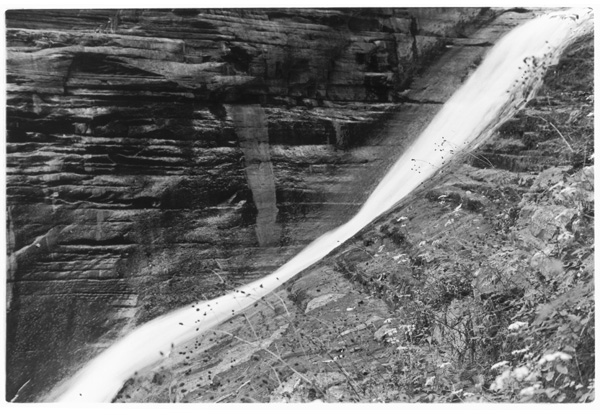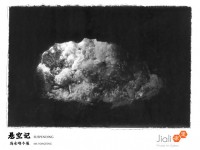
Suspending: Ma Yongfeng Solo exhibition
|
EMERGENCE With this new exhibition at Jiali Gallery, after several years of inquiries in the field of social intervention, installation and participatory practice, Ma Yongfeng simultaneously, comes back to photography and back to the white box. The way he does it, with the “Suspending” series marks an interesting and pivotal phase of his artistic expression. These small gelatin silver photographs embody a way to look, in which contemporary issues and the need to build a bridge with Chinese traditional culture meet in a discreet but transformative way. The images have been printed in small formats, slightly irregular, whose range is dictated by the size of the vintage paper.The small size and the relatively large number of images lead the viewer through an intimate experience during which time slows down: to see all the pictures we need to get close and to spend several minutes. I was attracted since the beginning by this sequence of pictures whose size is slightly different .They create an interesting rhythm for the eye to watch: an irregular alternation which gives the viewer a first overall feeling and then leads him to carefully pay attention to every single piece. The pictures are divided in 10 series, and although the first references that come up when we look at them could be found in the tradition of Eastern philosophy, we can also read them through the prism of another critical thought, a Western one this time. Charles Baudelaire, in his seminal poem “Correspondences” states : “La Nature est un temple où de vivants piliers Baudelaire caused here a rupture between the word and the thing, between the act of transcribing and the object recorded. The “correspondences” are arbitrarily turning the signs into symbolic substitutes that do not name but suggest. Most of Ma Yongfeng images taken one by one, seem informal inquiries into forms and motives of Chinese history, art and philosophy, (with nature as a key metaphorical element) but their narrative and hierarchy are disrupted in each series, by an unexpected element whose intrusion opens the possibility to make new associations and find new meanings which cannot be controlled or predicted anymore: nor by the artist, neither by the viewer. The fact that Ma chose to put together pictures he took by himself and others taken from internet archives increases the sense of indeterminacy and ambiguity;being both photographer and photo-editor he operates a juxtaposition between the relocation of narrative space and the re-appropriation of parallel time which bring new hidden meaning visible on the surface. Technically wise, we observe that composition is neither strict, nor repetitive: it does not follow any pre-established rule, and, instead it changes continuously in an organic way.Here another form of accuracy is searched, one in which the artist is not trying to do anything “too well”. There is no need to re-touch, and no attempt to fake that whatsoever element is more than what it really is: a different form of sensibility is at work: it is the need to find a resonance somewhere between one’s inner life and the outside world close by. An hidden current generates an impulse that will eventually take the form a poetic gesture,the “Suspending” series capture the emergence of this poetic gesture before it takes form, before it is defined. It is a zero-degree of the image, an unconscious reflection whose references can be traced back to Malevich’s white square as to Artaud’s definition of the “double”: an invisible mirror that exists and reflects from “beyond”, echoing the kind of interaction we know in physics between matter and anti-matter. The artist restrains himself from describing it, or representing it didactically because then it would be gone, dead.To suspend it, instead, means to testify it while it appears, in a sort of “limbo” zone where emotion, aesthetic experience and form are still undifferentiated. The “suspending” series is also an interesting way to cast a bridge between the language of traditional Chinese art and the contemporary one.In the whole process of shooting, developing the images and putting them together for this exhibition, Ma’s process reminds a famous exercise Jerzy Grotowski used in his Poor Theater training:when a person is trying to learn and sing an old anonymous popular song from the past for the first time, he is constantly searching in a playful but accurate way, for the rhythm of the melody and the sound of the words, until an uncertain but extremely lively connection appears. Because he knows the melody too well, the voice is hesitant but full of tension and desire….in this way the person can discover how space and time are codified in the rhythm: it will be different if it is a song from the mountain or from the plain, as the voice will come out differently. Who sang this song for the first time? Was it a shepherd alone by the fireplace or a rower along the river, or a mother to a child? All the information are in the song. Through this archaeological regression, Grotowski explains in a well known article called “Tu est le fils de quelq’un” (You are someone’s son), it is possible to get in touch again with one’s own origin, memory and identity in a larger sense. Ma Yongfeng operates in a similar way, using the photographic medium and the symbolic elements of traditional culture, (the stone, the water, the bamboo, the trees) and the apparently random elements to dig inside the collective unconscious and make us lose our grip at the same time as he lets go of his own. On this fragile and subtle level of perception, the safety of expertise is abandoned for risk and potentiality. What is the connection between Chinese metaphorical landscapes, a woman’s sex and nuclear mushrooms? Maybe we should ask ourselves “where do these pictures come from?”Are they coming from MA or from all of us?…or from somewhere else? Jacques Monod in his book “Le hasard et la necessite’” (Chance and necessity), says that the initial event, the transformation, is a matter of chance, then once this event is inscribed in a living organism, it is replicated and translated billions of times and enters the field of necessity. Suspending exists right between chance and necessity and only in this kind of tension-potential, in which the past and the present touch each other briefly, the seeds of a future radical transformation can grow. That is what Ma Yongfeng seems to suggest if we try to read these images from a socially and politically engaged point of view.The way Chinese intellectuals and artists traditionally challenged the status quo, was to leave the city and to find in nature both a physical refuge and a source of symbolic elements that they would use in their art to send a message to the power. In his famous painting “Wild Grass”, Shi Tao, the famous artist born towards the end of the Ming dynasty, depicts a road overgrown with wild grass. He express the fact that even if roads are supposed to be convenient for people to walk along, wild grass can grow over a road and destroy its usefulness: in the same way when corrupted officials interfere too much with people’s lives, existence becomes unbearable. Shi Tao wrote a simple inscription on the painting “They all grow in the middle of the road” . With Suspending Ma Yongfeng suggests to us we should slow down and step aside from the speed and brutality of the outside world and stand still and listen carefully. He invites us to re-invent our inner landscapes and cultivate the potential for change until the right occasion, like the half-head of the Buddha, will emerge from the border. Alessandro Rolandi, Beijing 2014
|
 |

